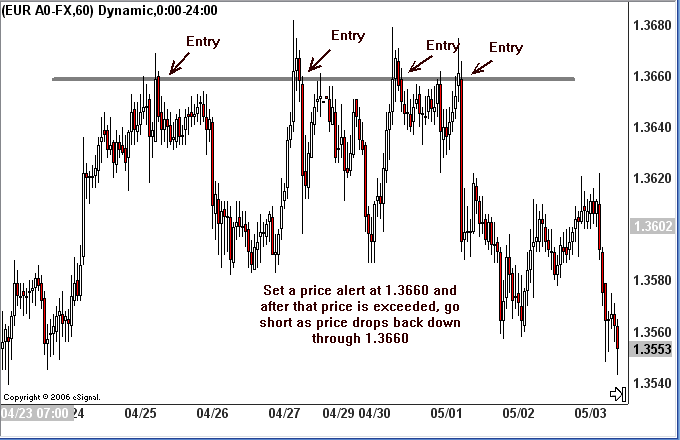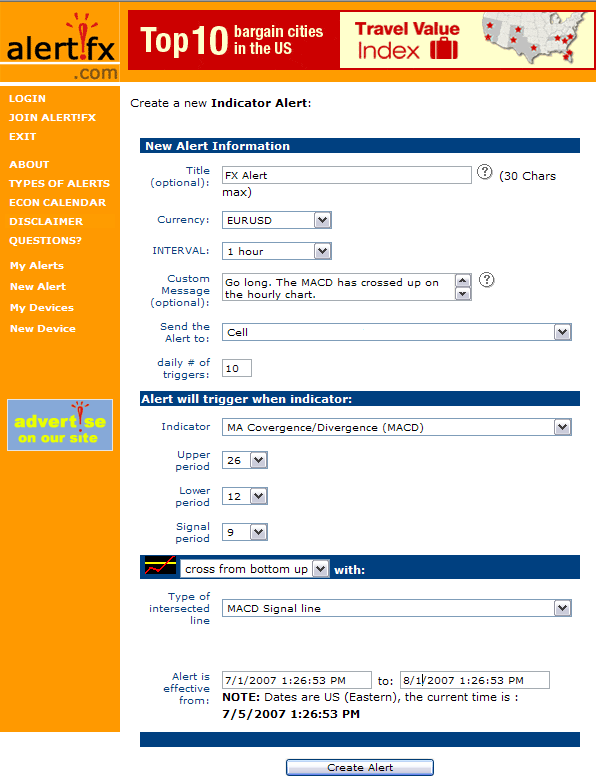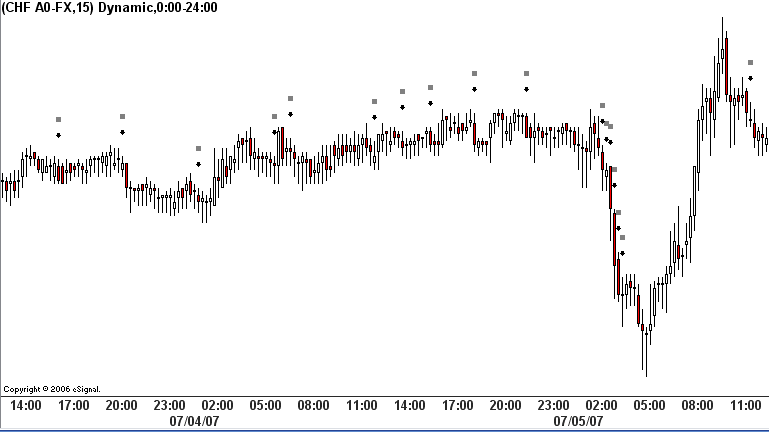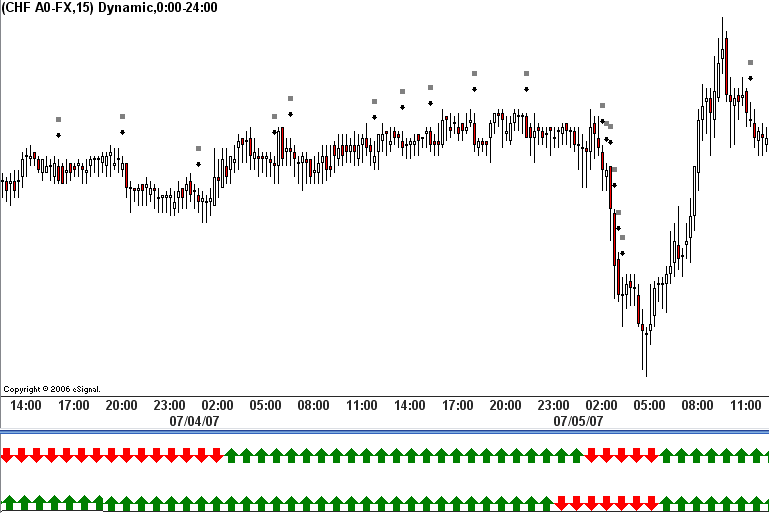Forex Trading Articles
MANAGING THE 24-HOUR CURRENCY MARKET WITH TRADE ALERTS
By Teresa Burnett for Forexmentor.com
©
2007, Currex Investment Services Inc.
Jul 8, 2007
The hours the currency markets are open for trading constitute a classic good news/bad news situation. I thought when I first became interested in the currency markets that a 24 hour a day market would allow me to be at the computer trading when it suited me. However, I soon found out that the markets were not necessarily moving at the times when I was available to trade.
Perhaps other traders can relate to this: countless times I would be watching a currency pair chart for hours or even days setting up for a trade but not quite the “confluence of events” I wanted, only to take a dinner break and miss the eventual confluence of indicators and miss the move entirely. Or, I retired early for the evening in order to “catch the action” at the London open, only to discover the next morning that a significant price move in multiple currency pairs happened an hour or two after I had turned off the computer for the evening far in advance of the London open.
“If only,” I thought, “the computer could monitor my charts and send me an alert.” Within a few months this wish has come true. I am catching more of my trade setups by making extensive use of trade alerts.
Alerts range from simple price alerts to complex custom programs. Alerts can be set through most trading platforms, through alert services such as www.alertfx.com, or through charting software such as FX AccuCharts or eSignal.
Price Alerts
Most of us are first introduced to the idea of using alerts through the basic price alert which is the ability to choose a price at which our trading platform or charting service will notify us when a currency pair trades through that price. Price alerts are very useful when you have a clear support or resistance point in mind.
For example, the week of April 23, 2007 Peter Bain mentioned in the ForexMentor AM Review that the EUR/USD pair would meet considerable resistance at 1.3660 and it certainly did. There were multiple opportunities to set rate alerts and make plays off the 1.3660 price as this level was repeatedly tested over the next several days. (Illustration 1)

Illustration 1
Price frequently makes multiple moves up to a resistance level before making a significant drop. Alternately, price often moves down to a support level and tests it repeatedly before making a move up. Illustration 1 also shows a good trade entry strategy for taking trades based on resistance. Since we are not certain how far past a point of resistance or how far below a point of support price will go, we can enter the trade as price moves back through the original alert point. For example, in Illustration 1, price exceeded the 1.3660 resistance point. Rather then going short the moment price first touched 1.3660 and the price alert sounded, this illustration shows taking the trade as price dropped back down through the 1.3660 level. This can be accomplished using a second price alert or a sell entry stop order entered after the first alert is received. The opposite holds true for going long at support points. This strategy assumes the support and resistance levels are well known and other indicators align. In my experience Peter Bain’s call of currency support and resistance levels is quite accurate.
Indicator Alerts
More commonly those of us who rely on technical indicators for trade entry and exit points are looking for one or more technical indicators to reach a pre-defined level. For example, I might want to know when a MACD has crossed the signal line, or when a moving average “Golden Cross” has occurred, or when a Bollinger Band has been exceeded. Before my charting software allowed indicator alerts, I was grateful to be introduced to a free alert web site which Seth Gregory mentioned in the ForexMentor PM Preview. This site is www.alertfx.com where you may register and set alerts based on indicators. (Illustration 2)

Illustration 2
As of this writing, Alertfx.com only supports setting alerts on six major currency pairs and two yen cross pairs. However, for ForexMentor members trading through FX Solutions the new enhanced charting package FX AccuCharts supports setting indicator alerts for every technical indicator that can be applied to a chart for all the currency pairs that can be traded through FX Solutions.
FX AccuCharts also has some sophisticated indicators utilizing combinations of technical analysis tools that will plot a mark on the candle/bar where the occurrence of the technical event such as a bearish engulfing candle pattern has occurred (TraderMarks). Or highlight a bar /candle if a condition is met (TraderBars). Each of the FX AccuCharts indicators can be customized using a built-in editor. (I have not had the opportunity to research this editor, but hope to be able to for a future article).
Custom Programmed Alerts
Not long after starting to use indicator alerts, I realized for these alerts to be truly effective I would need to monitor and be alerted when several indicators in several different time frames had reached a particular state. For example, in a prior article titled, “The Right Trade Entry Checklist” I wrote about my favorite confluence of indicators: a 60minute and 15min MACD crossing the signal line paired with a 15min Stochastic “overbought“. Since this particular combination of indicators is not available in any standard indicator alert service nor any charting software I know of, I learned to develop custom programmed alerts using the charting software eSignal.
eSignal, like most charting packages, has extensive built-in indicators. In addition to the built-in indicators, eSignal allows custom indicators to be developed and applied to charts. This is accomplished through a formula scripting language called EFS which is an extended version of JavaScript 1.5. Although I began my career as a computer programmer, I was a bit daunted by the idea of learning JavaScript. I knew it would most likely take me weeks if not months to work through all the eSignal tutorials. Fortunately, I learned that eSignal has a formula development wizard. By utilizing it, the formula wizard literally “walked me through” the process of creating a custom formula. Within a few days, I was able to program a custom alert that monitored my charts for the combination of a 60min MACD crossed down, a 15min MACD crossed down, and a 15min Stochastic “overbought” (or price still within 20 pips of a recent overbought point). Each time the formula detected the combination of these indicators it would send a text message to my cell phone, pop-up a message on my computer screen, play an audible alert through my computer’s speakers, and plot the point on the chart
Be Careful What You Ask For: Strengths and Weaknesses of Programmed Alerts
After using my new custom alert formulas for a few weeks, I knew I wanted to invest the time to perfect them. I have the ambitious goal of programming the custom formulas with the knowledge I have about analyzing charts so that I will be notified of my preferred entry and exit points via an alert, rather than spending hours myself each day analyzing charts. On the way to achieving this dream, I am learning much and therefore my trade alert formulas are continually evolving.
One of the first changes I made to my initial system of short trade alerts based on the 60minute and 15min MACDs and the 15min Stochastic, was to broaden the state of the indicators, in particular allowing for the MACD to be crossed up if it were also still below the zero line as it usually is in downtrend continuations. And to allow a narrow tolerance value to catch a MACD that was just about to cross the signal but not exactly mathematically “crossed”. A change which is more inline with how I visually assess a chart.
The particular combination of indicators mentioned above is designed to catch uptrend reversals and downtrend continuation patterns. And they do so fairly reliably. However, after programming these indicators into a trade alert, I realized that these same indicators also show up at other times and produce alerts that I don’t want to take.
For example, Illustration 3 shows the USD/CHF currency pair with several up trends, down trends, and choppy sideways movement. The arrows directly above the candles show the times when my rules apply and an alert to go short or “sell” has fired. As you can see this combination of indicators that should be catching tops/reversals and downtrend continuations is also firing in up trends and in choppy directionless conditions.

Illustration 3
Therefore, I made a significant enhancement to my formula to appeal to a higher power -- a higher time frame chart -- to give me an indication of the trend. After several months of programming and testing, I have a good algorithm for doing this.
llustration 4 shows the same currency pair with the same go short or sell signals plotted above the candles. There are also two rows of arrows plotted at the bottom of the chart. The top row of arrows represents the longer term trend calculated using a daily chart,. The bottom row of arrows represents a shorter term trend calculated by using the four hour chart. Therefore, the most reliable go short or sell signals occur when the two trend arrows are pointing down. These two trend arrows paired with the trade signals are now producing fairly reliable alerts, catching most good setups with minimal spurious alerts.

Illustration 4
Over time, the two trend arrows plotted on the bottom of the chart are becoming a trusted signal in and of themselves, meaning when both are pointed up it indicates a good long entry and when both are pointed down it indicates a good short entry. Currently, I am programming and testing alerts for other indicators including the Bollinger Band trade setups documented in the Dec, 2006 article I wrote titled, “Using Bollinger Bands for Forex Trading”, setups such as price touches of “flat” Bollinger Bands on higher time frame charts, etc.
I hope these thoughts have been of benefit to others who are considering programming their trade entry criteria into alerts. And as my trade alerts evolve, I promise more articles on this topic.
Other Forex Trading Strategy Articles


|
